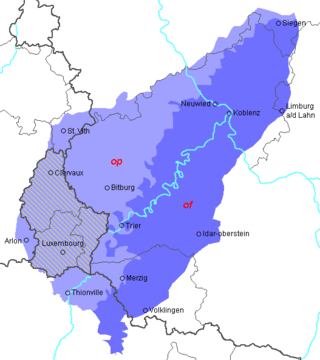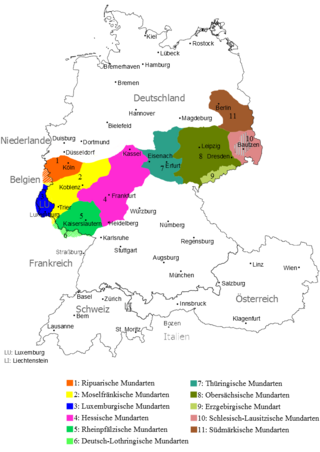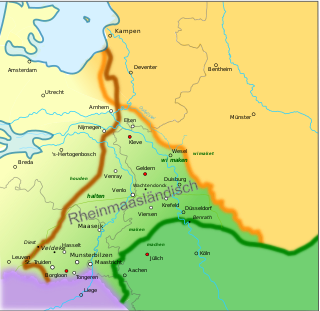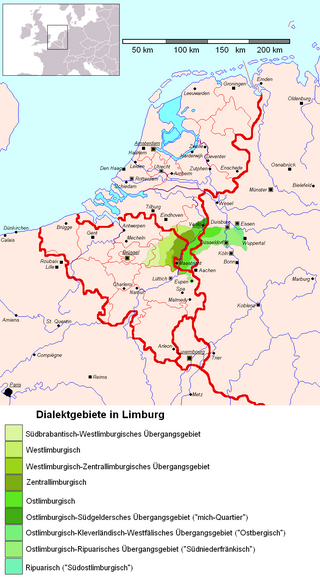The High German languages, or simply High German – not to be confused with Standard High German which is commonly also called "High German" – comprise the varieties of German spoken south of the Benrath and Uerdingen isoglosses in central and southern Germany, Austria, Liechtenstein, Switzerland, Luxembourg, and eastern Belgium, as well as in neighbouring portions of France, Italy, the Czech Republic (Bohemia), and Poland. They are also spoken in diasporas in Romania, Russia, Canada, the United States, Brazil, Argentina, Mexico, Chile, and Namibia.

In historical and comparative linguistics, Low Franconian is a linguistic category used to classify a number of historical and contemporary West Germanic varieties closely related to, and including, the Dutch language. Most dialects and languages included within this category are spoken in the Netherlands, northern Belgium (Flanders), in the Nord department of France, in western Germany, as well as in Suriname, South Africa and Namibia.

West Central German belongs to the Central, High German dialect family of German. Its dialects are Franconian and comprise the parts of the Rhinelandic continuum located south of the Benrath line isogloss, including the following sub-families:
Colognian or Kölsch is a small set of very closely related dialects, or variants, of the Ripuarian group of dialects of the Central German group. These dialects are spoken in the area covered by the Archdiocese and former Electorate of Cologne reaching from Neuss in the north to just south of Bonn, west to Düren and east to Olpe in northwest Germany.

Limburgish, also called Limburgan, Limburgian, or Limburgic, is a West Germanic language spoken in the Dutch and Belgian provinces of Limburg and in the neighbouring regions of Germany.

Ripuarian is a German dialect group, part of the West Central German language group. Together with the Moselle Franconian which includes the Luxembourgish language, Ripuarian belongs to the larger Central Franconian dialect family and also to the Rhinelandic linguistic continuum with the Low Franconian languages.

Frankish, also known as Old Franconian or Old Frankish, was the West Germanic language spoken by the Franks from the 5th to 9th century.

Moselle Franconian is a West Central German language, part of the Central Franconian languages area, that includes Luxembourgish. It is spoken in the southern Rhineland and along the course of the Moselle, in the Siegerland of North Rhine-Westphalia, throughout western Rhineland-Palatinate and Saarland, Luxembourg, the south of the German-speaking Community of Belgium and in the neighboring French département of Moselle. The Transylvanian Saxon dialect spoken in the Transylvania region of Romania is derived from this dialect as a result of the emigration of numerous "Transylvanian Saxons" between 1100 and 1300, primarily from areas in which the Moselle Franconian dialect was then spoken. Another variety of Moselle Franconian, the Hunsrik, is spoken in some rural areas of southern Brazil, brought by 19th century immigrants from the Hunsrück region in modern Germany.

Central German or Middle German is a group of High German languages spoken from the Rhineland in the west to the former eastern territories of Germany.

Lorraine Franconian is an ambiguous designation for dialects of West Central German, a group of High German dialects spoken in the Moselle department of the former north-eastern French region of Lorraine.

Rhenish Franconian or Rhine Franconian is a dialect chain of West Central German. It comprises the varieties of German spoken across the western regions of the states of Saarland, Rhineland-Palatinate, northwest Baden-Württemberg, and Hesse in Germany. It is also spoken in northeast France, in the eastern part of the département of Moselle in the Lorraine region, and in the north-west part of Bas-Rhin in Alsace. To the north, it is bounded by the Sankt Goar line which separates it from Moselle Franconian; to the south, it is bounded by the Main line which is also referred to as the Speyer line which separates it from the Upper German dialects.

German dialects are the various traditional local varieties of the German language. Though varied by region, those of the southern half of Germany beneath the Benrath line are dominated by the geographical spread of the High German consonant shift, and the dialect continuum that connects German to the neighboring varieties of Low Franconian (Dutch) and Frisian.

Franconian or Frankish is a collective term traditionally used by linguists to refer to many West Germanic languages, some of which are spoken in what formed the historical core area of Francia during the Early Middle Ages.

In linguistics, Meuse-Rhenish is a term with several meanings, used both in literary criticism and dialectology.

Central or Middle Franconian refers to the following continuum of West Central German dialects:
Peter Honnen is a German linguist and specialist researcher of the languages of the Rhineland. He was born in Rheinhausen, Germany.

Bergish is a collective name for a group of West Germanic dialects spoken in the Bergisches Land region east of the Rhine in western Germany.
The Eifeler Regel or Eifel rule is a linguistic phenomenon originally documented in the dialects of the Eifel region in the far west of Germany during the late 19th century. The rule describes a phonological process in the languages which causes the deletion of final in certain contexts, and may be reflected in spelling.
The terms Rhinelandic, Rhenish, and Rhinelandic regiolect refer to the vernacular lect spoken in the so-called Rhineland of West Germany. This linguistic region is approximately formed of the West of North Rhine-Westphalia, the North of Rhineland-Palatinate and several smaller adjacent areas, including some areas in neighbouring countries.
The Eifel dialects are those dialects spoken in the Eifel mountains of Germany. They divide into two language regions: the dialects spoken in the southern Eifel (Eifelisch) are part of the Moselle Franconian dialect group and closely resemble Luxembourgish. In the northern Eifel, by contrast, the dialects (Eifelplatt) belong to the Ripuarian dialect group and are more like Öcher Platt or Kölsch. In between there is a dialect continuum of typical transitions, whereby more or less every village speaks a little differently from its neighbours.













